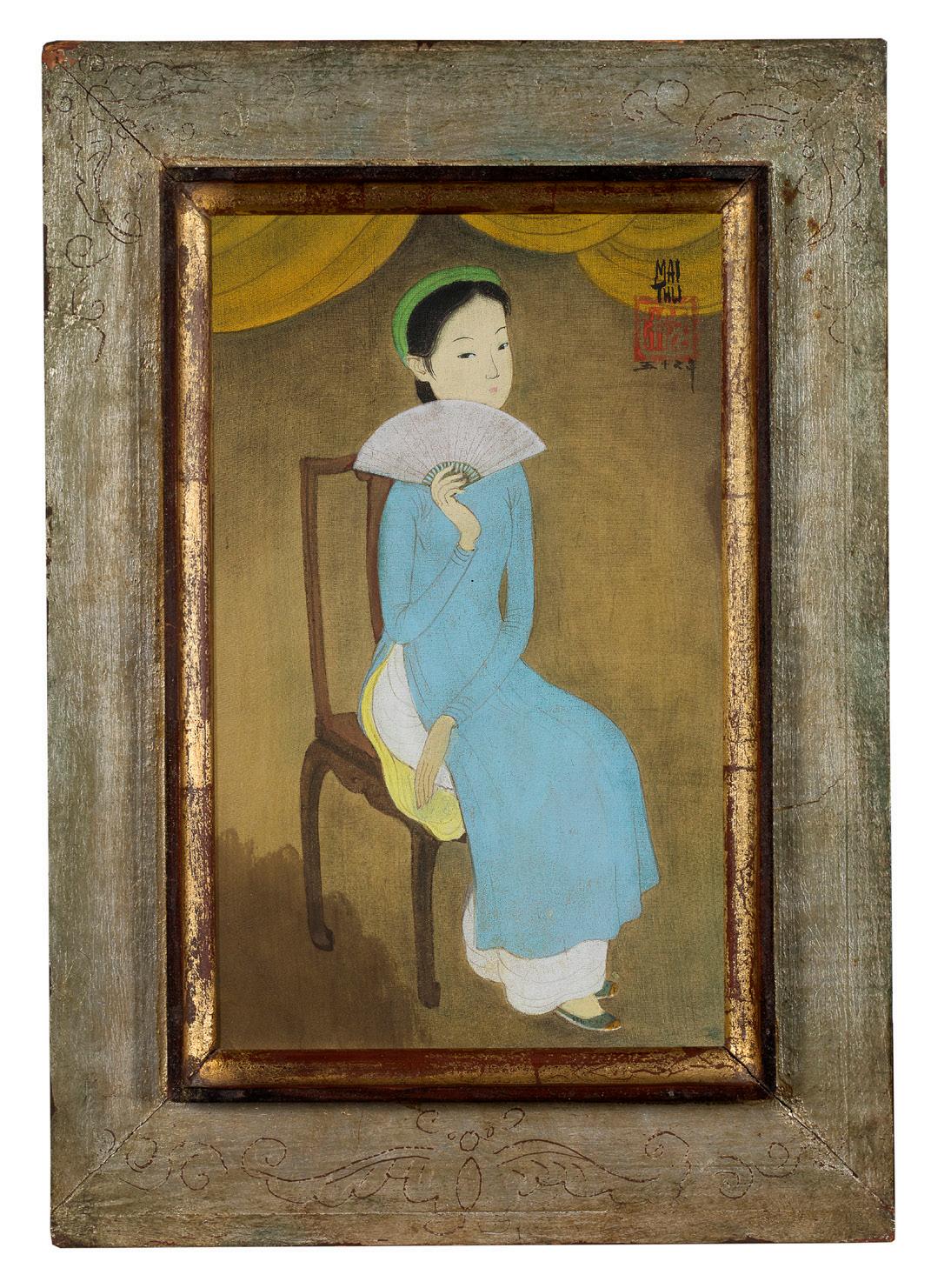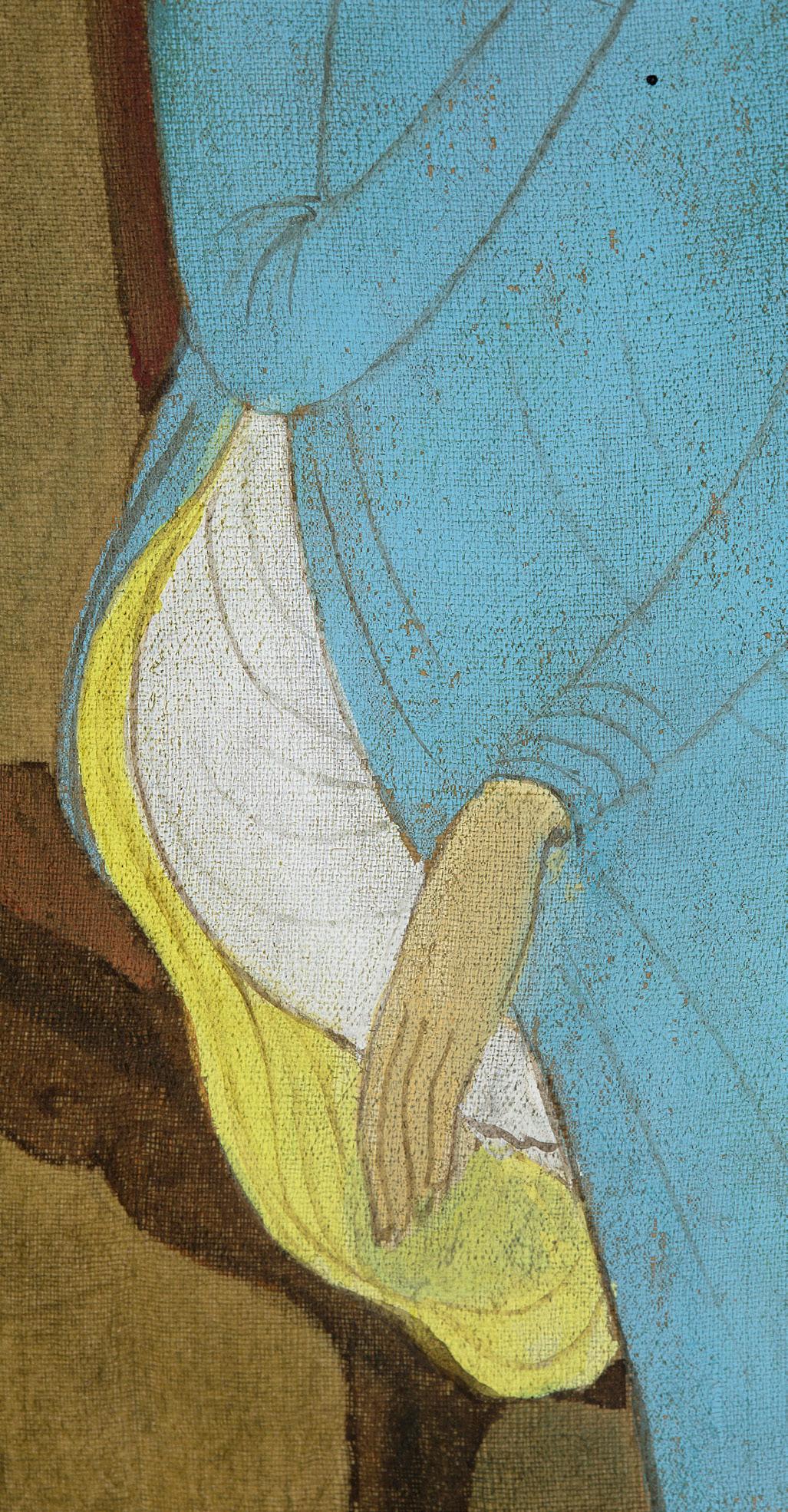
4 minute read
MAI TRUNG THỨ FEMME À L’ÉVENTAIL, 1957
MAI TRUNG THỨ (1906-1980)
Femme à l’éventail, 1957
Encre et couleurs sur soie, signée et datée en haut à droite, titrée au dos. Dans le cadre d’origine réalisé par l’artiste 23,7 x 15 cm - 9 1/4 x 5 7/8 in.
Ink and color on silk, signed and dated upper right, titled on the back. In its original frame made by the artist.
50 000 - 80 000 €
Une attestation d’inclusion au catalogue raisonné de l’artiste actuellement en préparation par Charlotte Aguttes-Reynier pour l’association des Artistes d’Asie à Paris sera remise à l’acquéreur.
PROVENANCE
Collection privée, France
Élève de la première promotion de l’École des Beaux-Arts d’Indochine, Mai Trung Thứ s’est imposé comme l’un des artistes les plus appréciés et reconnus de sa génération. Incarnant avec brio le savant mélange des cultures occidentales et extrême-orientales, ses œuvres ont très vite connu une certaine renommée. À la fin des années 1950, il commence à réaliser des petits formats permettant ainsi une plus large diffusion de son œuvre. Avec une minutie qui lui est propre, l’artiste transforme ces petits formats en véritable travail d’orfèvre. Artiste à part entière, Mai Trung Thứ travaille l’œuvre dans son ensemble et s’applique à la réalisation des cadres.
Si l’évolution stylistique de l’artiste peut être marquée par trois périodes, ses sources d’inspirations restent constantes. Parmi elles, le sujet féminin est particulièrement traité. Leurs silhouettes graciles et leurs chevelures ébènes apportent à ses compositions la vision d’un Vietnam traditionnel.
Peintre de la féminité, Mai Trung Thứ s’est appliqué à retranscrire la beauté de ses modèles à la manière de portraits posés.
Mai Trung Thứ, sinh viên khóa đầu tiên của Trường Mỹ thuật Đông Dương, đã tự khẳng định là một trong những họa sĩ được đánh giá cao và được công nhận nhất trong thế hệ của mình. Thể hiện xuất sắc sự pha trộn khéo léo giữa văn hóa phương Tây và Viễn Đông, các tác phẩm của ông nhanh chóng đạt được danh tiếng nhất định. Vào cuối những năm 1950, ông bắt đầu vẽ tranh kích thước nhỏ, do đó cho phép phân phối tác phẩm của mình rộng rãi hơn. Bằng sự tỉ mỉ vốn có, người họa sĩ đã biến những khuôn khổ nhỏ này thành tác phẩm nghệ thuật tinh xảo thực thụ. Là một họa sĩ thành đạt, Mai Trung Thứ làm việc trên toàn bộ khía cạnh của tác phẩm nghệ thuật và cống hiến cả cho việc thực hiện các khung tranh.
Nếu sự phát triển phong cách của họa sĩ có thể được đánh dấu bằng ba thời kỳ, thì nguồn cảm hứng của ông vẫn không đổi. Trong đó, chủ đề phái nữ đặc biệt quan trọng. Bóng dáng uyển chuyển và mái tóc mun của họ mang đến cho sáng tác của ông hình ảnh về một Việt Nam truyền thống.
Mai Trung Thứ, một họa sĩ của phái nữ, đã cố gắng chuyển tải vẻ đẹp của những người mẫu dưới dạng những bức chân dung được tạo dáng.
Mai Trung Thứ, a student of the first class of the Indochina School of Fine Arts, has established himself as one of the most appreciated and recognized artists of his generation. Brilliantly embodying the skilful blend of Western and Far Eastern cultures, his works quickly gained a certain reputation. At the end of the 1950s, he began to produce small formats, thus allowing a wider distribution of his work. With a meticulousness that is his own, the artist transforms these small formats into a real work of goldsmith. An accomplished artist, Mai Trung Thứ works on the artwork as a whole and is dedicated to the realization of the frames.
If the stylistic evolution of the artist can be marked by three periods, his sources of inspiration remain constant. Among them, the female subject is particularly important. Their graceful silhouettes and their ebony hair bring to his compositions the vision of a traditional Vietnam.
Mai Trung Thứ, a painter of femininity, has endeavored to transcribe the beauty of his models in the form of posed portraits.
Dans Femme à l’éventail , son modèle se tient assis de trois-quarts, tenant gracieusement son éventail de la main droite, son regard croisant celui du spectateur. Le statut social de cette jeune élégante se devine à travers le raffinement de ses chaussons délicatement brodés. La tenture ornant le plafond et une chaise typiquement asiatique complètent la composition. Exploitant les codes du genre du portrait occidental, Mai Trung Thứ se différencie grâce à une technique propre à son apprentissage à l’École des BeauxArts d’Indochine. L’utilisation d’encre et de gouache en lavements successifs sur la soie apporte une sensibilité et une douceur uniques. Maîtrisant depuis plusieurs années cette technique, la fin des années 1950 est marquée par une introduction de couleurs plus vives. Ainsi le bleu de l’áo dài mais également le jaune de la teinture ou de l’intérieur de sa tenue, ou encore le vert du bandeau apportent des tonalités joyeuses dans une composition sobre.
Trong Người phụ nữ với cái quạt , người mẫu của ông ngồi ba phần tư, tay phải cầm chiếc quạt một cách duyên dáng, ánh mắt của cô nhìn vào người xem. Địa vị xã hội của người phụ nữ trẻ thanh lịch này được thể hiện rõ qua sự tinh xảo của đôi dép thêu hoa. Trần nhà cùng với một chiếc ghế châu Á điển hình hoàn thành bố cục. Khai thác những đặc điểm của thể loại chân dung phương Tây, Mai Trung Thứ tạo sự khác biệt cho mình bằng một kỹ thuật đặc trưng khi ông học tại Trường Mỹ thuật Đông Dương. Việc sử dụng mực và bột màu trong các lớp liên tiếp trên lụa mang lại sự nhạy cảm và mềm mại độc đáo. Cuối những năm 1950 được đánh dấu bằng sự ra đời của nhiều màu sắc sống động hơn, vì ông đã thành thạo kỹ thuật này trong vài năm. Màu xanh của tà áo dài, cả màu vàng trên trang phục, hay màu xanh của chiếc khăn trên đầu mang đến những sắc thái tươi vui trong một bố cục trang nhã.
In Femme à l’éventail, his model is seated three-quarters, gracefully holding her fan in her right hand, her gaze meeting that of the viewer. The social status of this elegant young woman is evident in the refinement of her delicately embroidered slippers. The hanging on the ceiling together with a typically Asian chair complete the composition. Exploiting the codes of the Western portrait genre, Mai Trung Thứ differentiates himself through a technique specific to his apprenticeship at the Indochina School of Fine Arts. The use of ink and gouache in successive layers on the silk brings a unique sensitivity and softness. The end of the 1950’s was marked by the introduction of more vivid colors, as he had mastered this technique for several years. Thus, the blue of the áo dài but also the yellow of the dye or the inside of her outfit, or the green of the headband bring joyful tones in a sober composition.











